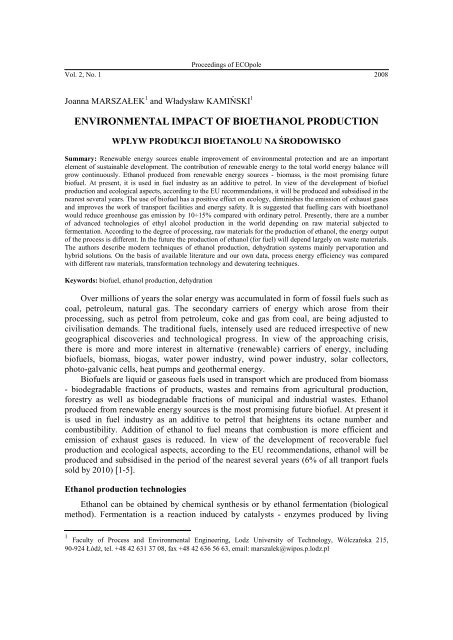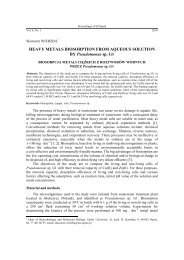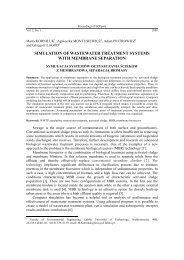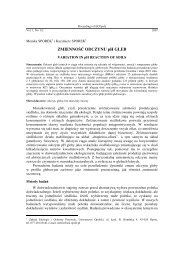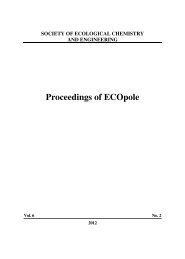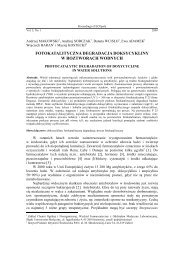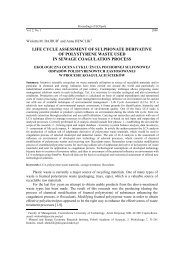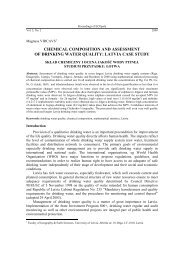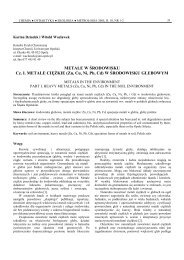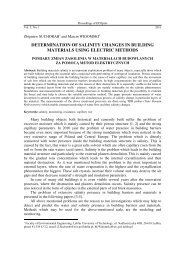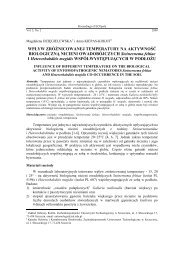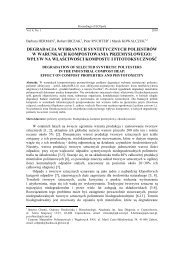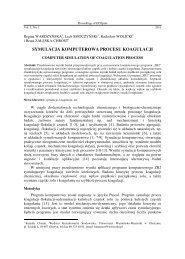ENVIRONMENTAL IMPACT OF BIOETHANOL PRODUCTION
ENVIRONMENTAL IMPACT OF BIOETHANOL PRODUCTION
ENVIRONMENTAL IMPACT OF BIOETHANOL PRODUCTION
You also want an ePaper? Increase the reach of your titles
YUMPU automatically turns print PDFs into web optimized ePapers that Google loves.
Proceedings of ECOpole<br />
Vol. 2, No. 1 2008<br />
Joanna MARSZAŁEK 1 and Władysław KAMIŃSKI 1<br />
<strong>ENVIRONMENTAL</strong> <strong>IMPACT</strong> <strong>OF</strong> <strong>BIOETHANOL</strong> <strong>PRODUCTION</strong><br />
WPŁYW PRODUKCJI BIOETANOLU NA ŚRODOWISKO<br />
Summary: Renewable energy sources enable improvement of environmental protection and are an important<br />
element of sustainable development. The contribution of renewable energy to the total world energy balance will<br />
grow continuously. Ethanol produced from renewable energy sources - biomass, is the most promising future<br />
biofuel. At present, it is used in fuel industry as an additive to petrol. In view of the development of biofuel<br />
production and ecological aspects, according to the EU recommendations, it will be produced and subsidised in the<br />
nearest several years. The use of biofuel has a positive effect on ecology, diminishes the emission of exhaust gases<br />
and improves the work of transport facilities and energy safety. It is suggested that fuelling cars with bioethanol<br />
would reduce greenhouse gas emission by 10÷15% compared with ordinary petrol. Presently, there are a number<br />
of advanced technologies of ethyl alcohol production in the world depending on raw material subjected to<br />
fermentation. According to the degree of processing, raw materials for the production of ethanol, the energy output<br />
of the process is different. In the future the production of ethanol (for fuel) will depend largely on waste materials.<br />
The authors describe modern techniques of ethanol production, dehydration systems mainly pervaporation and<br />
hybrid solutions. On the basis of available literature and our own data, process energy efficiency was compared<br />
with different raw materials, transformation technology and dewatering techniques.<br />
Keywords: biofuel, ethanol production, dehydration<br />
Over millions of years the solar energy was accumulated in form of fossil fuels such as<br />
coal, petroleum, natural gas. The secondary carriers of energy which arose from their<br />
processing, such as petrol from petroleum, coke and gas from coal, are being adjusted to<br />
civilisation demands. The traditional fuels, intensely used are reduced irrespective of new<br />
geographical discoveries and technological progress. In view of the approaching crisis,<br />
there is more and more interest in alternative (renewable) carriers of energy, including<br />
biofuels, biomass, biogas, water power industry, wind power industry, solar collectors,<br />
photo-galvanic cells, heat pumps and geothermal energy.<br />
Biofuels are liquid or gaseous fuels used in transport which are produced from biomass<br />
- biodegradable fractions of products, wastes and remains from agricultural production,<br />
forestry as well as biodegradable fractions of municipal and industrial wastes. Ethanol<br />
produced from renewable energy sources is the most promising future biofuel. At present it<br />
is used in fuel industry as an additive to petrol that heightens its octane number and<br />
combustibility. Addition of ethanol to fuel means that combustion is more efficient and<br />
emission of exhaust gases is reduced. In view of the development of recoverable fuel<br />
production and ecological aspects, according to the EU recommendations, ethanol will be<br />
produced and subsidised in the period of the nearest several years (6% of all tranport fuels<br />
sold by 2010) [1-5].<br />
Ethanol production technologies<br />
Ethanol can be obtained by chemical synthesis or by ethanol fermentation (biological<br />
method). Fermentation is a reaction induced by catalysts - enzymes produced by living<br />
1 Faculty of Process and Environmental Engineering, Lodz University of Technology, Wólczańska 215,<br />
90-924 Łódź, tel. +48 42 631 37 08, fax +48 42 636 56 63, email: marszalek@wipos.p.lodz.pl
66<br />
Joanna Marszałek and Władysław Kamiński<br />
cells. There are a number of advanced technologies of ethyl alcohol production in the world<br />
presently, depending on the raw material subjected to fermentation. The raw materials<br />
containing simple sugars and suitable for direct processing through fermentation are white<br />
beet and its processing products, sugar cane, domestic and citrus fruits, some tropical plants<br />
(punk), juices of certain trees (birches, maple), honey. The group of raw materials<br />
containing starch and polysaccharides, such as cellulose and inulin used for the production<br />
of ethanol should comprise cereals in form of food grain of rye, barley, corn, oat, wheat,<br />
sorghum, besides also vegetable bulbs of potato vegetable roots, seeds of bifoliate plants,<br />
fruits, timber, grass, moss, etc. Using current production technology the cheapest<br />
bioethanol produced in world comes from sugarcane in Brazil and in Europe from starch<br />
crops [6].<br />
Presently the production of ethanol (for fuel) largely depends on waste materials:<br />
lignocellulosic biomass such as crop residues, wasted and energy crops (switchgrass),<br />
fast-growing trees such as poplar and willow, waste paper and package material, cereals in<br />
form of grain unsuitable for consumption, domestic and agricultural waste (maize and<br />
wheat stalks) [7-11]. However ethanol production from lignocellulosic biomass is not yet at<br />
commercial scale, even though many technologies are mooted. The total potential<br />
bioethanol production from crop residues and wasted crops is about 16 times higher than<br />
the current world ethanol production (31·10 9 dm 3 in 2001) [12].<br />
a)<br />
b)<br />
c)<br />
Fig. 1. Ethanol energy balance depending on applied production technologies: a) based on processed materials,<br />
b) currently worked out technologies, c) future technologies<br />
Production costs of bioethanol vary and are dependent on the prices of raw materials,<br />
the method of production, the extent of refining undertaken and the supplementary
Environmental impact of bioethanol production<br />
utilisation of bio-products and waste. Depending on the degree of processing the raw<br />
materials for the production of ethanol, the energy output of the process defined as the ratio<br />
of energy contents and energy supplied for production is different. The energy output in<br />
case of ethanol production ranges from 1.7 to 3.8. The more processed the materials<br />
subjected to fermentation, the lower the energy gain of the entire process (Fig. 1). Hence<br />
the current vast interest in biofuel production technologies using waste materials eg<br />
agricultural and forest waste such as straw or shavings. Among other eg the continuous<br />
production process composed of thermo-pressure hydrolysis, enzymatic hydrolysis,<br />
fermentation and ethanol dewatering is proposed, which is characterised by a high level of<br />
heat recovery and recuperation (2.95) and low production price (0.24 EUR/kg EtOH) [13].<br />
Another alternative for the future are biorefinery - multisystems producing fuels, solvents,<br />
plastics and food from waste biomass and involving ethanol and lactic acid fermentation<br />
[14].<br />
Ethanol dehydration methods<br />
Ethanol obtained during ethanol fermentation and rectification has about 95% vol.<br />
ethanol. Production of anhydrous ethanol used for fuel purposes requires overcoming the<br />
barriers of a positive homoazeotrope. Now, the most important ethanol dehydration<br />
techniques used in the world industry include azeotropic distillation and dehydration on<br />
molecular sieves.<br />
An alternative to the traditional methods of ethanol dehydration is pervaporation (PV)<br />
or vapour permeation (VP) - the new generation of membrane separation techniques<br />
[15-17]. During pervaporation, a liquid stream is separated on a semi-permeable membrane<br />
into two streams: a gaseous permeate (enriched with a water) and liquid retentate (enriched<br />
with ethanol) [18]. A comparison of the costs of ethanol dehydration by various techniques<br />
in a bigger system (Tab. 1) indicates that operating costs of the membrane techniques (PV<br />
and VP) are smaller by half than other dehydrating methods.<br />
Table 1<br />
Comparison of the cost of ethanol dehydration (94% mass) by various techniques [US $/Mg] [19, 20]<br />
Operating costs<br />
Vapour<br />
permeation<br />
Pervaporation<br />
Azeotropic distillation<br />
(cyclohexane)<br />
Adsorption on<br />
molecular sieves<br />
Vapour pressure reduction - 3.2 25÷37.5 20<br />
Water cooling 1 1 3.75 2.5<br />
Electric energy 10 4.4 2 1.3<br />
Distillation component - - 1.2÷2.4 -<br />
Exchange of membranes or<br />
sieves<br />
4.75 4 - 8 - 12.5<br />
Total cost 15.75 12.6÷16.6 31.95÷45.65 36.3<br />
Pervaporation is economically justified when at the inlet water concentration in the<br />
system is less than 10% and when at the outlet we expect dehydration of the order of<br />
100÷10 ppm of its content. If still higher product dehydration is expected, then much bigger<br />
membrane surface and higher pressure reduction on the side of permeate is required. Cost<br />
of ethanol dehydration decreases with an increase of permeation flux and mass fraction of<br />
ethanol in permeate and grows with an increase of membrane cost.<br />
67
68<br />
Joanna Marszałek and Władysław Kamiński<br />
When analysing the literature on the subject, it is possible to identify concrete trends in<br />
the development of pervaporation in ethanol dehydration industry. The PV installation can<br />
be an independent, final stage of dehydration (in order to overcome the azeotropic point),<br />
a direct stage after fermentation process (to concentrate the ethanol below the azeotropic<br />
concentration) or an element of a hybrid solution combined with the presently used<br />
techniques (distillation and dehydration on molecular sieves).<br />
In literature there are many examples of hybrid processes of pervaporation with<br />
distillation [19, 21, 22]. Such hybrid processes enable savings of operating costs (lower<br />
energy demand, not use of additives) but not always of investment outlays (process<br />
complexity and high membrane prices). The development of hybrid processes of<br />
distillation-pervaporation and broad applications in industry will depend not only on high<br />
process efficiency but first of all on reduction of the membrane cost. The hybrid systems<br />
will bring about economic advantages at long-term processes but they are not profitable in<br />
the case of small ethanol dehydration systems.<br />
Beside building of new ethanol dehydration systems based on hybrid processes of<br />
distillation-pervaporation, producers offer also implementation of the pervaporation in the<br />
already existing installations [15]. The PV module can be placed between the distillation<br />
and azeotropic column, this will be a double increase of efficiency and related reduction of<br />
energy cost, dehydration costs, more efficient use of the existing system and a possibility to<br />
control the PV module. Similarly, the PV module can be connected to the already existing<br />
dehydration on molecular sieves, this will cause an increase of process efficiency and the<br />
quantity and quality of water removed, reduction of product recirculation degree and energy<br />
consumption. Just this last application that consists in placing PV between distillation and<br />
adsorption on molecular sieves, can bring in the future the biggest economic benefits in the<br />
process of ethanol dehydration.<br />
Reduction in greenhouse gas emissions<br />
The estimation of greenhouse gas and energy balances of bioethanol is complex. For<br />
comparison with fossil fuels the full fuel cycle must be considered: production which<br />
required inputs and combustion which is considered to be CO2-neutral. The final<br />
accounting is country-specific and is a function of raw material cultivated, the associated<br />
agricultural yield and utilisation of by- and co-products.<br />
Table 2<br />
Overview of CO2 eq. emissions (cultivation, production, distribution and vehicle emissions) saving from<br />
bioethanol compared with reference fossil fuel vehicle [23]<br />
Feedstock<br />
CO2 eq. emission savings<br />
[g/km] [Mg/1000 dm 3 ]<br />
Sugar crops 90 1,2<br />
Starch crops 30 0,4<br />
Lignocellulosic crops 183 2,5<br />
Lignocellulosic residues 191 2,6<br />
Brazilian sugarcane 212 2,9<br />
Table 2 presents total greenhouse gas emissions weighted in terms of their global<br />
warming potentials, as a result of utilising bioethanol over the corresponding fossil fuel.<br />
Use of European bioethanol yields a CO2 emissions savings of 13÷83% compared with
Environmental impact of bioethanol production<br />
operation of standard petrol vehicle. Bioethanol produced from Brazilian sugarcane has<br />
a better well-to-wheels energy balance and CO2 emissions savings above 85% [23-25].<br />
Conclusion<br />
The dwindling fossil fuel resources and their increasing prices have led to a wordwide<br />
search for alternative energy resources so the demand for alternative fuels is on the increase<br />
these days. Using biofuel has a positive effect on ecology, diminishes the emission of<br />
exhaust gases and improves the work of transport facilities and energy safety. The<br />
biochemical method of ethanol production is less expensive and more efficient. Some<br />
governments are undergoing a fundamental change in their preference of fuel sourcing.<br />
References<br />
[1] European Union Commission. White Paper for a Community Strategy and Action Plan Energy for the<br />
Future: Renewable Sources of Energy 1997 (COM/97/599).<br />
[2] Jonquiéres A., Clément R., Lochon P., Néel J., Dresch M. and Chrétien B.: Industrial state-of-the-art of<br />
pervaporation and vapour permeation in the western countries. J. Membr. Sci., 2002, 206, 87-117.<br />
[3] Warshaw B.: The future is bright for bioethanol. Petrol. Rev., 2002, 56(664), 26-27<br />
[4] Zanin G.M., Santana C.C., Bon E.P.S., Giordano R.C.L., De Moraes F.F., Andrietta S.R., Coelho<br />
De Corvalho Neto C., Macedo I.C., Lahr Fo.D., Ramos L.P. and Fontana J.D.: Brazilian Bioethanol<br />
Program. Appl. Biochem. Biotechnol.-A Enzyme Eng. Biotechnol., 2000, 84-86, 1147-1161.<br />
[5] Van Wyk J.P.H.: Wastepaper as a bioenergy resource. Biocycle, 2000, 41(2), 80.<br />
[6] Ryan L., Convery F. and Ferreira S.: Stimulating the use of biofuels in the European Union: Implications for<br />
climate change policy. Energy Policy, 2006, 34, 3184-3194.<br />
[7] Kim S. and Dale B.E.: Global potential bioethanol production from wasted crops and crop residues.<br />
Biomass and Bioenergy, 2004, 26, 361-375.<br />
[8] Murphy J.D. and McCarthy K.: Ethanol production from energy crops and wastes for use as a transport fuel<br />
in Ireland. Appl. Energy, 2005, 82,148-166.<br />
[9] Demirbas A.: Bioethanol from cellulosic materials: A renewable motor fuel from biomass. Energy Sources,<br />
2005, 27(4), 327-337.<br />
[10] Paszner L.: Bioethanol - Fuel of the future. Pulp and Paper Canada, 2006, 107(4), 26-29.<br />
[11] Azizov A. Sh.: The obtaining of fuel bioethanol. Appl. Solar Energy, 2006, 42(3), 55-56.<br />
[12] Berg C.: Worldethanol production 2001. The distillery and Bioethanol Network. Available at<br />
http://www.distill.com/world_ethanol_production.htm<br />
[13] Low-cost technology to produce high-grade ethanol from agricultural and forest wastes. Cordis focus RTD<br />
Supplement 2006, 59, 19.<br />
[14] Ohara H.: Biorefinery. Appl. Microbiol. Biotechnol., 2003, 62, 474-477.<br />
[15] Sulzer Chemtech, Pervaporation and vapor permeation technology. Application of pervaporation (brochure).<br />
Sulzer Chemtech, Switzerland 2004.<br />
[16] Kujawski W.: Application of pervaporation and vapor permeation in environmental protection. Polish<br />
J. Environ. Stud., 2000, 9,13-26.<br />
[17] Kamiński W. and Marszałek J.: Pervaporation for Drying and Dewatering. Dry. Techn., 2006, 24, 835-847.<br />
[18] Rautenbach R.: Membrane processes (in Polish). WNT, Warsaw 1996, 151-354.<br />
[19] Sander U. and Soukup P.B.: Design and operation of pervaporation plant for ethanol dehydration.<br />
J. Membr. Sci., 1988, 36, 463-475.<br />
[20] Sander U. and Soukup P.B.: Practical experience with pervaporation systems for liquid and vapour<br />
separation. J. Membr. Sci., 1991, 62, 67-89.<br />
[21] Baker R.W.: Pervaporation, membrane separation systems - recent developments and future directions.<br />
William Andrew Publishing, Noyes 1991, 161-186.<br />
[22] Gooding C.H. and Bahouth F.J.: Membrane-aided distillation of azeotropic solution. Chem. Eng. Com.,<br />
1985, 35, 267-279.<br />
[23] Ryan L., Convery F. and Ferreira S.: Stimulating the use of biofuels in the European Union: Implications for<br />
climate change policy. Energy Policy, 2006, 34, 3184-3194.<br />
69
70<br />
Joanna Marszałek and Władysław Kamiński<br />
[24] Bomb Ch., McCormick K., Deurwaarder E. and Kaberger T.: Biofuels for transport in Europe: Lesson from<br />
German and UK. Energy Policy, 2007, 35, 2256-2267.<br />
[25] Demirbas A.: Progress and recent trends in biofuels. Progr. Energy&Combustion Sci., 2007, 33, 1-18.<br />
WPŁYW PRODUKCJI BIOETANOLU NA ŚRODOWISKO<br />
Streszczenie: Odnawialne źródła energii umoŜliwiają zarówno poprawę stanu ochrony środowiska, jak i są<br />
waŜnym elementem zrównowaŜonego rozwoju. Udział energii odnawialnej w ogólnym bilansie energetycznym<br />
świata stale wzrasta takŜe z powodu zmniejszenia emisji gazów i minimalizacji odpadów. Etanol wytwarzany ze<br />
źródeł odnawialnych, jakim jest m.in. biomasa, jest najbardziej obiecującym biopaliwem przyszłości. Póki co,<br />
uŜywany jest w przemyśle paliwowym jako dodatek do benzyny. Z uwagi na szybki rozwój produkcji paliw<br />
i aspekty ekologiczne, zgodnie z wytycznymi Unii Europejskiej, zarówno produkcja etanolu, jak i jego dodatek do<br />
paliw będzie wzrastać w najbliŜszych latach. Biopaliwa przynoszą pozytywny efekt ekologiczny, obniŜając emisję<br />
gazów wylotowych, polepszając zdolność spalania i bezpieczeństwo energetyczne. Przewiduje się, iŜ samochody<br />
na bioetanol w porównaniu z konwencjonalnymi mogłyby zredukować emisję gazów szklarniowych o 10÷15%.<br />
Obecnie na świecie istnieje wiele zaawansowanych technologii produkcji alkoholu etylowego w zaleŜności od<br />
surowca poddawanego fermentacji. Stopień zaawansowania technologii i przetworzenia surowca wpływa na<br />
wydajność energetyczną procesu. Przewiduje się, iŜ w przyszłości produkcja etanolu do celów paliwowych<br />
w duŜej mierze zaleŜeć będzie od surowców odpadowych. Autorzy opisują nowoczesne techniki produkcji<br />
etanolu, systemów odwadniania, w tym głównie perwaporacji i rozwiązań hybrydowych. Na podstawie dostępnej<br />
literatury i własnych doświadczeń porównano wydajność energetyczną procesu w zaleŜności od zastosowania<br />
surowców, technologii i technik odwadniania.<br />
Słowa kluczowe: biopaliwo, produkcja etanolu, odwadnianie


